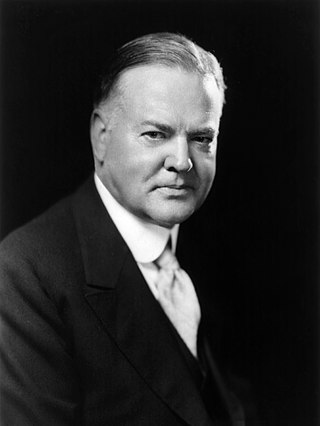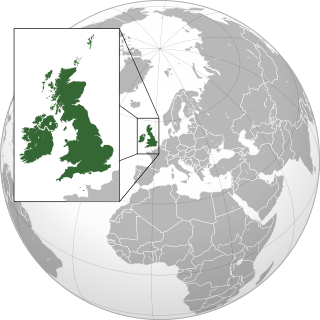
Herbert Clark Hoover was an American politician who served as the 31st president of the United States from 1929 to 1933. He was a member of the Republican Party, holding office during the onset of the Great Depression in the United States. A self-made man who became rich as a mining engineer, Hoover led the Commission for Relief in Belgium, served as the director of the U.S. Food Administration, and served as the U.S. Secretary of Commerce.

The current United States Ambassador to the Holy See is Joe Donnelly, who replaced the ad interim Chargé d'Affaires, Patrick Connell, on April 11, 2021. The Holy See is represented by its apostolic nuncio, Archbishop Christophe Pierre, who assumed office on April 12, 2016. The U.S. Embassy to the Holy See is located in Rome, in the Villa Domiziana. The Nunciature to the United States is located in Washington, D.C., at 3339 Massachusetts Avenue, N.W.

There have been 40 United States presidential visits to Canada by 13 presidents over the past century. As the U.S. president is both head of state and head of government, these visits have taken many forms, ranging from formal state visits, to official visits, working visits, or private visits.
Fifteen presidents of the United States have made thirty-four presidential visits to Mexico. The first visit by an incumbent president to Mexico was made in 1909 by William Howard Taft. It was only the second time in U.S. history that a president left the country while in office.

Six United States presidents have made presidential visits to Sub-Saharan Africa. The first was an offshoot of Franklin D. Roosevelt's secretive World War II trip to French Morocco for the Casablanca Conference. More recently, Barack Obama, the first U.S. president with African American ancestry, visited his father's native Kenya in 2015. Of the 46 African nations identified as sub-Saharan by the United Nations, 14 have been visited by an American president.
Ten United States presidents have made presidential visits to Eastern Europe and Northern Asia. The first trip by an incumbent president to Eastern Europe was made by Franklin D. Roosevelt in 1945, to the Soviet Union, and was an offshoot of Allied diplomatic interactions during World War II. The first trip by an incumbent president to Northern Asia was made by Gerald Ford in 1974, also to the Soviet Union, and was an offshoot of U.S.–Soviet Détente during the Cold War. The first presidential visits to other Eastern European countries occurred during this era of easing geo-political tensions as well.

Eleven United States presidents and three presidents-elect have made thirty-four presidential visits to Central America. The first visit by an incumbent president to a country in Central America was made in 1906 by Theodore Roosevelt. The trip, to Panama, was the first international presidential trip in U.S. history, and signaled the start of a new era in how presidents conducted diplomatic relations with other countries. In 1928, Herbert Hoover, during the time when he was president-elect, visited the region during his historic "good will" trip, to Central and South America.

Nine presidents of the United States have made presidential visits to North Africa. The first trips by a sitting president to countries in North Africa were those of Franklin D. Roosevelt, and were an offshoot of Allied diplomatic interactions during World War II. Of the five countries in the region, only Libya has not yet been visited by an American president.

Ten United States presidents have made presidential visits to the Middle East. The first trips by an incumbent president to countries in the Middle East were those of Franklin D. Roosevelt, and were an offshoot of Allied diplomatic interactions during World War II. To date, 16 visits have been made to Egypt, 12 to Saudi Arabia, 11 to Israel, six to both Iraq, Jordan and Turkey, four to Iran, three to the Palestinian Territories, two to both Kuwait and Syria, one to Bahrain, Georgia, Oman, Qatar, and to the United Arab Emirates. No incumbent American president has yet visited Armenia, Azerbaijan, Cyprus, Lebanon, and Yemen.

Nine United States presidents and one president-elect have made presidential visits to the Caribbean since 1928. Franklin D. Roosevelt made the most trips to the Caribbean islands (14), either for vacation or while involved with Allied diplomatic interactions during World War II. Of the 13 sovereign countries in the region, four—Dominica, the Dominican Republic, Saint Kitts and Nevis, and Saint Vincent and the Grenadines—have not as of yet been visited by an American president.

Twelve United States presidents have made presidential visits to the United Kingdom and Ireland. The first visit by an incumbent president to the United Kingdom was made in December 1918 by Woodrow Wilson, and was an offshoot of American diplomatic interactions with the Principal Allied Powers at the conclusion of World War I prior to the Paris Peace Conference. The first visit by an incumbent president to Ireland was made in June 1963 by John F. Kennedy. To date, 39 visits have been made to the United Kingdom and eleven to Ireland.

Eight presidents of the United States have made presidential visits to South Asia. The first trip by a sitting president to South Asia was by Dwight D. Eisenhower in 1959. Of the eight countries in the region, only 4 of them have been visited by a sitting American president: Afghanistan, Bangladesh, India and Pakistan. The other four countries, Bhutan, the Maldives, Nepal and Sri Lanka, have never been visited by a sitting American president.

Ten United States presidents have made presidential visits to East Asia. The first presidential trip to a country in East Asia was made by Dwight D. Eisenhower in 1952. Since then, all presidents, except John F. Kennedy, have traveled to one or more nations in the region while in office.

Thirteen United States presidents have made presidential visits to Southern Europe. Woodrow Wilson became the first incumbent president to visit a Southern European country in January 1919 in the aftermath of World War I. Visits occurring during the 1940s through 1980s were offshoots of American diplomatic interactions during World War II and then the Cold War.

Thirteen United States presidents have made presidential visits to Western Europe. The first visits by an incumbent president to countries in Western Europe were made in 1918 and 19 by Woodrow Wilson in the aftermath of World War I. He was awarded the 1919 Nobel Peace Prize for his peacemaking efforts. Visits occurring during the 1940s through 1980s were offshoots of American diplomatic interactions following World War II and during the Cold War. To date, 40 visits have been made to France, 31 to Germany, 21 to Belgium, 11 to Switzerland, six to Austria, and five to the Netherlands. No president has yet visited Liechtenstein, Luxembourg or Monaco.

The presidential transition of Herbert Hoover began when he won the United States 1928 United States presidential election, becoming the president-elect, and ended when Hoover was inaugurated at noon EST on March 4, 1929.















